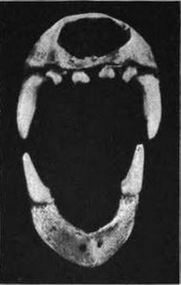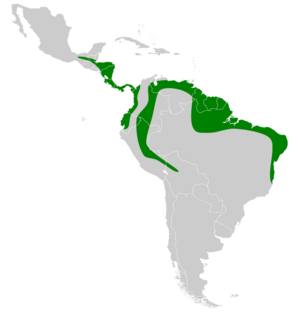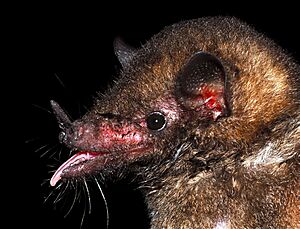Dark long-tongued bat facts for kids
Quick facts for kids Dark long-tongued bat |
|
|---|---|
 |
|
| Conservation status | |
| Scientific classification | |
| Genus: |
Lichonycteris
|
| Species: |
obscura
|
 |
|
| Synonyms | |
|
Lichonycteris obscurus Miller, 1900 |
|
The dark long-tongued bat (Lichonycteris obscura) is a small bat found in South America and Central America. It's known for its long tongue, which helps it eat. This bat is quite tiny, weighing about 6 to 11 grams, which is like a few paper clips. It measures about 46 to 63 millimeters long, which is shorter than a credit card.
This bat used to be thought of as the only species in its group, called Lichonycteris. But now, scientists know there are two species in this group. The other one is called the pale brown long-nosed bat.
The dark long-tongued bat lives mostly in old, natural forests. But you can also find it in other places. It has babies during the dry season in its home regions. Its diet includes nectar, pollen, and small insects.
Scientists consider this bat a species of "least concern" for now. This is because it lives in many places and in protected areas. However, in Ecuador, it is listed as "vulnerable," meaning it needs more protection there.
Contents
Discovering the Dark Long-Tongued Bat
The dark long-tongued bat was first described by a British scientist named Oldfield Thomas in 1895. He gave it the scientific name Lichonycteris obscura. He found a specimen of this bat in Managua, Venezuela.
The name Lichonycteris comes from ancient Greek words. Lichas means "hanging on the cliff," and nycteris means "bat." The second part of its name, obscura, is Latin for "dark-colored." This describes the bat's fur.
What the Dark Long-Tongued Bat Looks Like
The dark long-tongued bat is a small bat. Its forearm, which is part of its wing, is about 29.8 to 35.5 millimeters long. Its tail is short, only about 6 to 11 millimeters. The bat's total length is between 46 and 63 millimeters. As mentioned, adults weigh about 6 to 11 grams.
Its fur has three colors, with a dark brown band at the base of the hairs on its back. The fur on its back is a bit darker overall. The skin of its wings is attached to its feet. The bat's elbow and thumb bones are covered in thick fur.
The tail reaches its knees, and the tip sticks up from a well-developed membrane. This membrane connects to its ankles. The bat has a small, triangle-shaped nose-leaf and noticeable whiskers. Its snout is long and strong, and its lower jaw is longer than its upper jaw. This makes its lower lip stick out a bit. It doesn't have lower front teeth.
How the Bat Lives
Dark long-tongued bats often rest during the day in leaves of trees. They also use cracks under fallen trees near streams as temporary resting spots. These spots are helpful for bats moving from one area to another. They offer good access to food for short times.
Having Babies
These bats have their babies during the dry season in their tropical homes. Female bats with embryos have been seen in different months across various countries. For example, in Mexico in May, Guatemala in February, and Brazil in August.
Female bats that are feeding their young have been reported in Costa Rica in January and Ecuador in October. An embryo can weigh up to 30 percent of the mother bat's body weight.
What the Bat Eats
The dark long-tongued bat eats nectar from flowers, pollen, and insects. It helps pollinate many plants. For example, it pollinates Marcgravia vines and Vriesea bromeliads. It is also an important pollinator for a type of cactus called Weberocereus tunilla.
These bats have been seen feeding on nectar from many other plants too. In Mexico, most of the food found in their stomachs is pollen from Lonchocarpus plants. Sometimes, seeds from other plants are found in their droppings. This suggests they might also help spread seeds in places like Guatemala.
Where the Bat Lives
The dark long-tongued bat is found from southern Chiapas in Mexico, all the way south through Central America. In South America, it lives in the Andes mountains region. This includes countries like Venezuela, Guyana, Suriname, French Guiana, and the Amazon basin in Brazil.
It also lives on the Pacific side of the Andes in Venezuela, Colombia, and western Ecuador. On the Amazon side, it is found in Peru and Bolivia. These bats can live at elevations up to 1,000 meters high.
This bat mostly lives in old, natural forests like rainforests and savannas. But it can also be found in other places. These include dry shrublands, open grasslands, and even buildings in Nicaragua. They have been seen in fruit groves in Panama and logged forests in Venezuela.
Protecting the Bat
The International Union for Conservation of Nature (IUCN) lists the dark long-tongued bat as a species of "least concern." This means it is not currently in danger of disappearing. This is because it lives in many different places and in protected areas.
However, the bat is naturally uncommon in some areas where it lives. In Ecuador, it is listed as "vulnerable" on their Red List of Mammals. This means it faces a higher risk there. Threats to the bat include deforestation, which is when forests are cut down. Another threat is habitat fragmentation, which means its living areas are broken up into smaller pieces.



